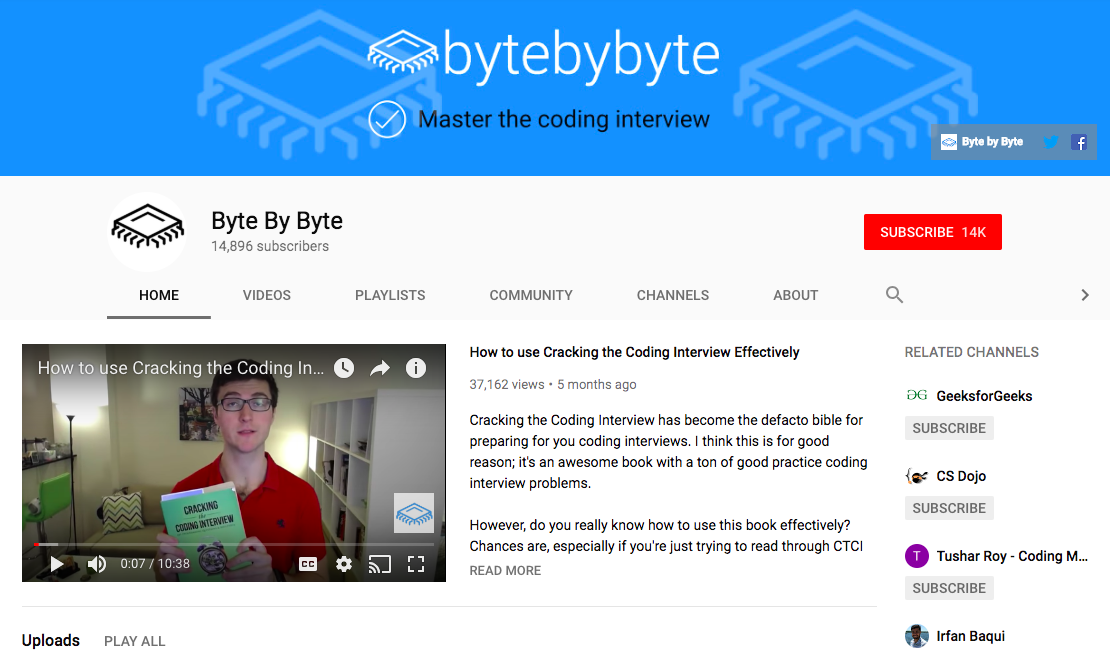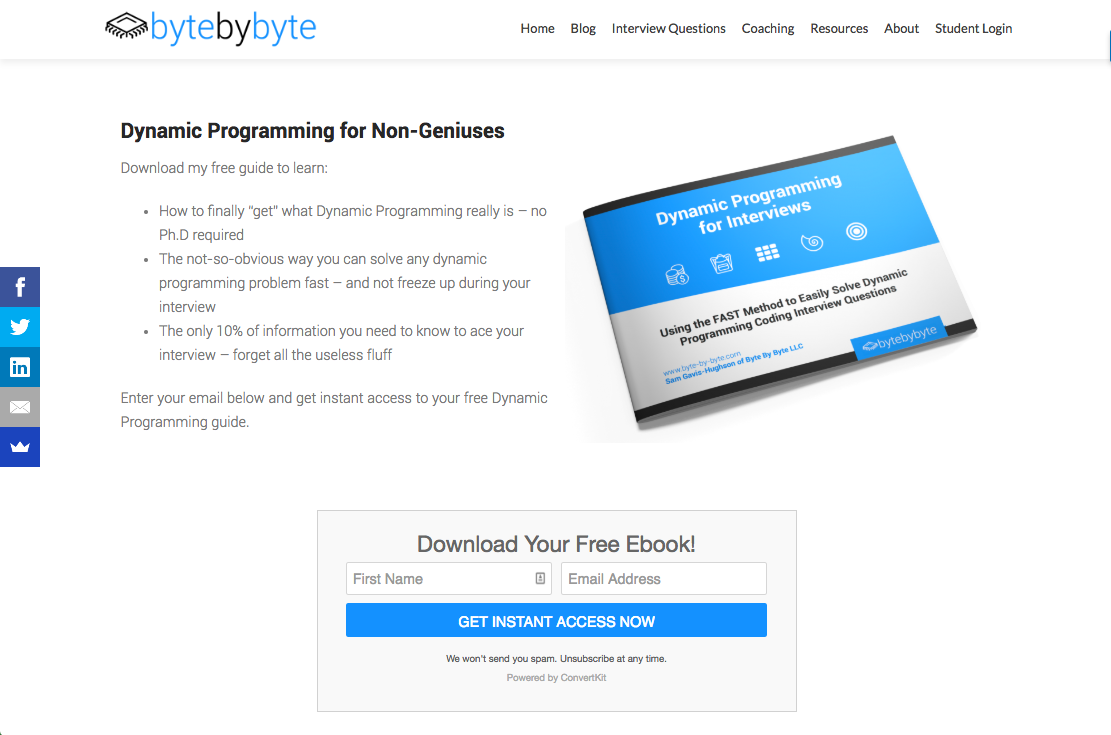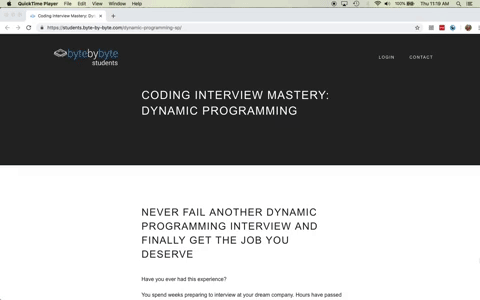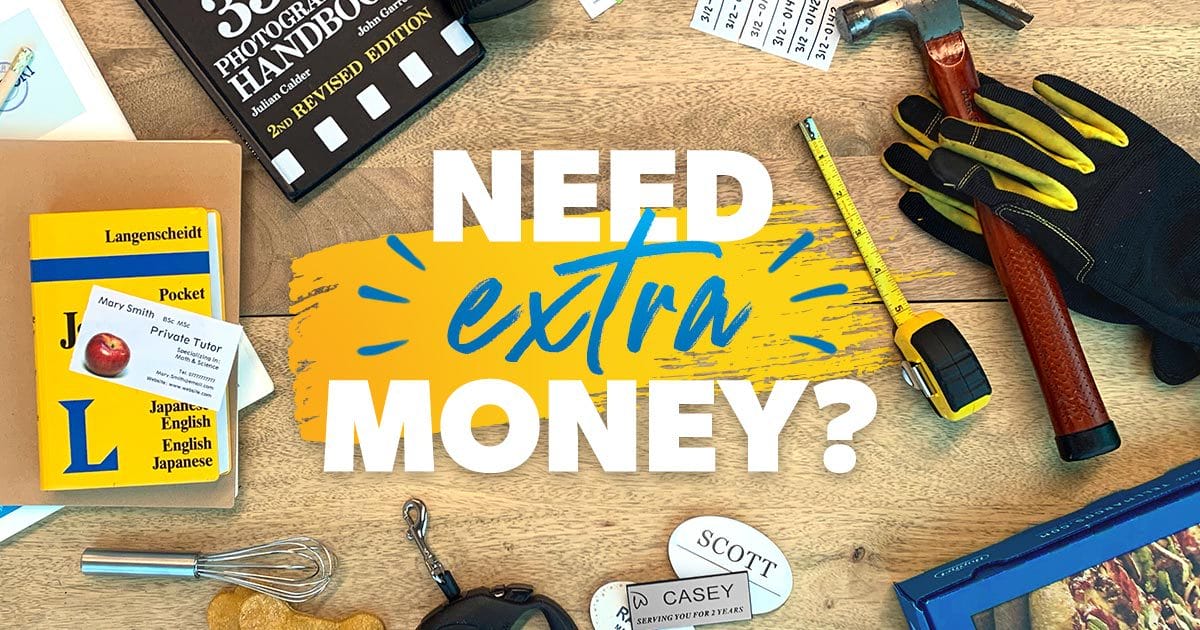
“What matters is the trajectory”: Inside a $15K product launch
Sam Gavis-Hughson doesn’t mince words about his state of mind at the beginning of the latest launch for his company, Byte by Byte: “I was freaking out.”
“This was by far the most expensive program that I’ve ever offered, as far as courses go. It was a huge test,” he says. “Everyone kept saying, ‘It’s going to be fine.’ But I got seven sales on the first day, which seemed incredibly low.”
Sam’s friends were right to reassure him. By the end of the launch, he’d brought in more than $16,000 in sales for his course, Coding Interview Mastery: Recursion — roughly 3X what he had done in previous launches.
Breakthrough stats: Byte by Byte

More than the number of zeroes (although those are nice, too), it’s that multiple that Sam is celebrating.
“There’s a trajectory,” he says. “From beginning of the year to three-quarters of the way through the year, there’s been 10X growth. That’s the interesting thing to me, is the trajectory of it.”
We asked Sam to walk us through his first few launches, and the lessons he learned along the way — including the tactics he applied for this most recent launch from GrowthLab’s new course on designing and executing successful launches, Breakthrough Launch.
Before the launch: The origins of Byte by Byte
Part of what made the success of this product launchso satisfying is that it was a long time in the making. By the time Sam launched the course, he had been working on Byte by Byte for more than two and a half years.
Like so many entrepreneurs we feature, the idea that became Byte by Byte started when Sam noticed that acquaintances were coming to him looking for a specific kind of help.
“A guy from my alma mater who was a year or two below me asked if I would do a mock interview [for a coding job],” he remembers. “And it kind of got me thinking: ‘You know, there a lot of books on interviewing, but there’s not a lot of good video content.’”
Sam decided to test his hypothesis in a Facebook group for developers. “I posted saying, ‘Hey, I’m thinking of doing videos going through practice interview questions. Shoot me an email if you’re interested,’” he says.
That post got Sam booted from the group for self-promotion, something he says has happened to him more than a few times. “I’ve been kicked out of pretty much every social media group I’ve been a part of. But it’s okay. It’s not the end of the world. You just go back, apologize, and ask to be let back in.”
And here’s the other thing: Before the community moderator dropped the hammer and removed Sam from the group, the post worked.
“I got emails from probably 30 people,” Sam remembers. “And that was my original email list.”
Included among the emails from the Facebook group came a message that Sam really hadn’t expected. “Someone emailed me like ‘Hey, can you coach me?’”
“That was my first paying client. It was right when I started. I was freaking out about what to charge him, because I had never done this before. So I ended up charging him, like, 30 bucks an hour. Which seems insanely cheap now, but back then, I was terrified.”
The 30 emails proved to Sam there was an unmet need in the coding community for clear, actionable advice about acing coding interviews. The person asking to pay him (and there would be more where he came from) confirmed something equally as crucial:
That people were willing and able to pay for his help.
Before the launch, part II: Growing and getting to know your audience
30 enthusiastic “yeses” from people in your target market is great. People asking to pay you before you even tell them you have something to sell is even better.
But 30 email subscribers and one paying coaching client do not a sustainable business make. If Sam wanted to grow Byte by Byte into a business that could support him full time, he needed to grow his audience.
Sam’s first serious effort at growing his audience came with the start of his YouTube channel, acting on his hunch that what coders were missing was simple, easily digestible video content tackling the most essential coding interview questions.

“I started doing videos 3 days a week,” he says. “So I got to 150 – 200 people doing that.”
150-200 people on your email list is nothing to turn your nose up at. But unless you have a 100% conversion rate or charge $1,500 per person, it’s not going to get you to $15,000 in a single launch. Sam’s real breakthrough, as far as growing his audience is concerned, came with the launch of his e-book, Dynamic Programming for Non-Geniuses.

In a way, this was Sam’s first true product launch, even if there was no money on the line. It was the first time he created a product for his audience, presented it to them, and asked them to opt in — with their email address, if not their wallet.
The response caught Sam by surprise. “Literally overnight my email lists went from about 500 to 1,500.”
With his roster of coaching clients growing, and the success of the Dynamic Programming e-book under his belt, Sam set his sights on his first-ever online course, Coding Interview Mastery: Dynamic Programming.
Launch #1: “Start with the recommendations, then modify from there”
Launching your first online course is a huge accomplishment by any standards. But Sam says that at the time, the course felt kind of like a letdown.
“It’s hard, because you have this epic flagship course in mind, which is what you want to launch. But it’s such a daunting task that you’re never going to do anything.”
The mindset Sam is referring to here is one we see a lot from aspiring entrepreneurs here at GrowthLab. If you can’t launch a flawless, epic, marquee-ready product, the thinking goes, you might as well not launch anything at all.
In hindsight Sam says that downsizing his ambitions for his first launch just a little was the right call. “I’m glad that I just did this like tiny little slice, because it at least got me moving in that direction.”

Sam initially introduced the Dynamic Programming course as an invite-only beta program in October 2017. The idea was to test the material with a select group of users, both to confirm that people would actually be willing to pay for the course, and to make sure the material was up to par before making it available to a wider audience.
Once the beta was completed and Sam had implemented the feedback, he moved on to an important milestone in any online entrepreneur’s life: his first full-scale product launch.
When it came to the structure of the product launch plan itself, Sam kept it simple, hewing closely to the recommendations laid out in another GrowthLab course, Zero to Launch.
“It was very cookie-cutter,” he says. “My approach with all of this has been: start with the recommendations, and then start to modify from there.”
Sam says his approach to mastering launches mirrors the advice he gives his own students about mastering coding problems.
“It’s sort of like cooking,” he says. “When you’re first learning to cook, just follow the recipe. And then, once you learn what you’re doing you can start to modify and experiment a little. But it’s like if you don’t know what you’re doing, don’t make changes.”
This “by the books” approach to a first launch paid off. By the end of first week of the launch, Coding Interview Mastery: Dynamic Programming had brought in $1,770 in revenue from 30 customers out of an email list of 2,863.
Launch #2: Harnessing the power of scarcity
In contrast to the by-the-book approach of his first launch, Sam’s second launch was all experimentation.
“I knew I wanted to raise the price of the course from $47 to $99,” he says. “So I decided to do a 24-hour mini-launch, just to give people one last chance to get in at the old price.”
It was a simple offer — I’m raising the price soon, get in now before the price goes up. But the results surprised Sam.
“My list was probably 6,000 people at the time and I sold 98 copies of the course in 24 hours,” he says. “That shocked me. That was way, way above what I was expecting, which was, like, 20.”
With the success of his second launch, Sam got a crash course in one hugely important tool in the sales psychology toolbelt. “It taught me how powerful scarcity is,” he says. “With my first launch, I didn’t use any scarcity. I didn’t close the launch. There was nothing. So it just, sort of started high, and then trailed off from there.”
Just by adding an element of scarcity — telling people, “Look, this course is only going to be available at this price for 24 hours, so you’d better get in now, if you’re interested” — Sam saw the dynamics of his launch completely change.
“So I’m going to be adding more scarcity from now on,” he says.
Launch #3: Action over consumption
With the success of the Dynamic Programming launches under his belt, Sam was ready to up the ante: new course, new price point — and a new approach to designing launches, which Sam implemented with help from Breakthrough Launch.
The new course was called Coding Interview Mastery: Recursion. It was a sequel of sorts to Coding Interview Mastery: Dynamic Programming, covering another tricky subject that programmers are expected to ace during high-stakes job interviews.
Before launching the course to his full list, Sam repeated the beta testing process he had gone through with his previous course, with one key exception: “This one had an application,” he explains. “There were 200 applicants, out of which I picked the top 60. Those 60 were given the opportunity to purchase.”
Out of the 60 invitees, 33 opted to purchase the course — at its full $197 price point, no less. With $6,500 in revenue from the beta, Sam was ready to move forward with a full-scale launch — which meant it was time to apply the lessons he had learned from Breakthrough Launch.
Sam says he approached the new material in a methodical way, similar to how he’s approached other GrowthLab products he’s used, like Zero to Launch and Behind the Sales Page.
“I sort of went through all the material and reviewed it once,” Sam explains. “Then when I actually had this launch coming up, I went back to it, and said, ‘Okay, let me step through this: what is the overarching theme here? What are the high-level strategies? What are the tactics, and how can I apply them to my launch?’”
That application part is key. In fact, it’s so important, it’s one of the first things we stress in Breakthrough Launch itself: action over consumption.
As our CEO, Ramit Sethi, explains in the course, learning to launch is a lot like learning to dance. “You don’t learn to dance by sitting at the bar creepily analyzing people’s moves,” he says. “You actually have to get up and give it a try!”
“Don’t just do MORE. Be strategic instead.”
“Action over consumption” doesn’t mean doing for the sake of doing.
That’s a lesson that Sam tries to pass on to his students. In fact, it was the main message of the sales funnel for Coding Interview Mastery: Recursion, which Sam designed with help from the Breakthrough Launch material.
“I started with this idea of people getting stuck in their interviews, which is a major problem that I see: people get stuck and they don’t know what to do about it. The way that they try and get unstuck is they just do more and more and more all the time. But they’re not strategic about it,” he explains. “So my message was, ‘Let’s be strategic instead.’”

That message — don’t just do MORE, be strategic instead — doubles as a pretty good summation of what Sam did with this launch.
A successful launch is not about piling every single conceivable possible bell and whistle you could add into your launch, he explains.“It’s about looking at each of the different options and saying, ‘Is this going to make a substantial enough difference in the total launch that I want to spend the time on it?’”
Adding a waitlist for those who missed the launch window, for example? “That was a whole other layer of technical complexity,” Sam explains. “I decided, ‘You know, at this scale it doesn’t make sense, because it’s not going to make that much of a difference.’”
Adding an upsell component, on the other hand? “That was pretty easy, adding a one-click upsell to the Dynamic Programming course,” he says. “I’d never tried doing something like that before. It converted at 19%, or about $700 of the launch total. So not nothing, but not a game-changer either. But I feel like it was worth doing just for the sake of testing.”
This is one way that Sam’s approach to launches has evolved by leaps and bounds since his first-ever launch way back in January 2018. Rather than doing the cookie-cutter approach of “just following the steps,” he’s starting to think critically about the needs of his specific product and his specific launch.
Ultimately, Sam says, every decision he makes with launches comes back to one core question: Will this get people to buy, or not?
“It’s your responsibility to get people to buy at any cost, because the best possible way that you can help someone is by getting them to buy your course or buy your product,” he explains. “I want to help as many people as I can. And as long as I’m confident in my product’s ability to do that, it’s my responsibility to get people to buy.”
“The trajectory is what makes a business”
And buy they did: by the end of the two-week launch of Coding Interview Mastery: Recursion, Sam had $16,871 in revenue from 57 customers.
With three successively more successful launches under his belt, Sam is feeling reflective about how far Byte by Byte has come in under a year.
“It’s interesting to reflect back and see where things have come from,” he says. “It’s kind of shocking, how much things have changed.”
At the same time that he’s celebrating how far he’s come, Sam is very much thinking about the future, and how to continue building on the foundation these first three product launches have given him.
“I think in 2019 we’re going to do well into six figures. Just looking at the trajectory, I think we have the assets now to be able to do that,” he says.
Which brings us full circle, to the one metric that Sam cares about more than anything else:
“It’s about the trajectory. That’s the key thing, right?” he says. “The specifics don’t matter. What matters is the trajectory, because the trajectory is what’s going to ultimately make a business.”
Want to build a business that enables you to live YOUR Rich Life? Get my FREE guide on finding your first profitable idea.
Host of Netflix’s “How To Get Rich” NYT Bestselling Author, & Host of the I Will Teach You To Be Rich Podcast. I’ll show you how to take control of your money with my proven strategies so you can live your RICH LIFE.
Written by Ramit Sethi
Host of Netflix’s “How To Get Rich” NYT Bestselling Author, & Host of the I Will Teach You To Be Rich Podcast. I’ll show you how to take control of your money with my proven strategies so you can live your RICH LIFE.



